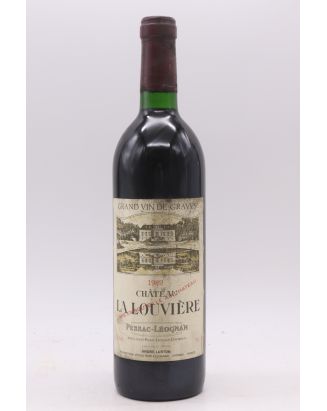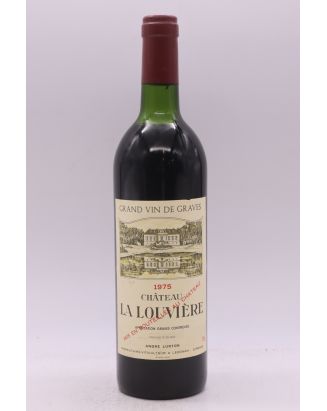







The origins of Château La Louvière date back to the early 14th century, when the Bordeaux region was still under English rule. In 1310, a modest dwelling called "La Lobeyra" was recorded in the registers of the English administration. It was between the 15th and 16th centuries that Pierre de Guilloche and his son Jean, from an influential family of Bordeaux parliamentarians, developed the estate's first vineyards. In 1620, the domain was ceded to the Carthusians of the Mercy of Bordeaux, who brought their expertise in winemaking, elevating the wines of La Louvière to the rank of highly prized crus by English and Flemish merchants.
During the French Revolution, ecclesiastical property was seized, and the estate was auctioned off in 1791. Jean-Baptiste Mareilhac, a wealthy Bordeaux merchant, became the owner and undertook the construction of the current magnificent château. Entrusted to the architect François Lhote, this classic, sober and elegant building was completed with frescoes and paintings by the Flemish artist François-Louis Lonsing.
In the following years, La Louvière remained a prestigious property, but decline set in during the 20th century. It was not until 1965, when the visionary André Lurton acquired the estate, that La Louvière regained its former splendour. André Lurton, a major player in Bordeaux viticulture, modernised the facilities and enhanced the vineyard, thus ensuring that La Louvière took its place among the great crus of Pessac-Léognan.
Château La Louvière benefits from an exceptional and diverse terroir, spanning 48 hectares of soils rich in gravel, sand, and limestone. These gravelly soils are characteristic of the Pessac-Léognan appellation and provide the vines with natural drainage, thus promoting the concentration of aromas and the finesse of the tannins. The geographical layout, with gentle slopes and deep soils, allows optimal ripeness of the grapes, contributing to balanced, powerful and complex wines.
The vineyard is divided into two parts: 13 hectares dedicated to white grape varieties (85% Sauvignon Blanc and 15% Sémillon) and 65 hectares devoted to red grape varieties. The red grape varieties are mainly Cabernet Sauvignon (55%) and Merlot (45%), whose roots delve deeply into the gravel, providing structure and finesse to the wines. With an average age of 21 years, the vines benefit from a dense planting of 7,500 vines per hectare, which promotes qualitative and rigorous production.
Winemaking at Château La Louvière combines respect for traditional methods and the use of modern techniques. For the red wines, the harvest is carried out manually, and the grapes are fermented in cement and stainless-steel vats at a controlled temperature. This process allows for precise extraction of aromas and tannins, giving the wines an intense and structured character. The malolactic fermentation takes place in vat, and the wine is then aged for 15 months in French oak barrels, of which about 50% are new.
The estate's white wines, on the other hand, undergo a specific vinification aimed at preserving their freshness and vibrancy. The Sauvignon and Sémillon grapes are pressed whole, without maceration. Fermentation begins in vat and is completed in oak barrels (45% new), where the wine is aged on the lees for nearly 9 months, depending on the vintage. This method produces elegant, complex white wines with fruity and floral aromas, and a beautiful liveliness.
The estate also benefits from the expertise of renowned consultants. Michel Rolland intervenes on the reds, bringing his knowledge of blending, while the whites are monitored by Valérie Lavigne, who ensures precise and respectful vinification of the grape varieties.
Château La Louvière offers a range of red and white wines that perfectly express the richness and diversity of its terroirs.
Château La Louvière Red
This main cuvée, composed mainly of Cabernet Sauvignon and Merlot, is a complex and structured wine. As it ages, it develops aromas of black fruits, spices and undergrowth, offering a beautiful length on the palate. Ideal for lovers of powerful wines, it pairs perfectly with red meat or game dishes.
Château La Louvière White
This dry white wine, made from Sauvignon Blanc and Sémillon, is of great elegance and freshness. Its aromas of citrus and exotic fruits are combined with floral and mineral notes. On the palate, it is lively and balanced, perfect for accompanying fish, seafood, or refined vegetarian dishes.
L de La Louvière Red
This second red wine is made with the same grape varieties as the main cuvée, but offers a more accessible profile. Light and fruity, it lends itself to more convivial tasting while retaining the distinctive characteristics of the estate. It is ideal for charcuterie, poultry or matured cheeses.
L de La Louvière White
This second white wine, made mainly from Sauvignon Blanc, offers a beautiful expression of freshness and fruitiness. Less complex than the grand vin, it proves perfect as an aperitif or with light dishes. Its aromas of lemon and green apple make it a pleasant and thirst-quenching wine.
The vintages of Graves and Pessac-Léognan, two Bordeaux appellations, stand out for their consistent quality. The years 1975, 1982, 1983, 1985, 1986, 1988, 1989 and 1990 are particularly prized for their finesse and balance. The vintages 1998, 2000, 2005, 2008, 2009 and 2010 are equally remarkable for their structure and ageing potential. More recently, the vintages 2012, 2014, 2015, 2016, 2017, 2018, 2019 and 2020 confirm this continuing excellence, with wines offering both elegance and longevity.
Explore all the Grands Crus Classés de Graves, an appellation renowned for the diversity and quality of its wines. At the top of the list, the First Growth of 1855, Château Haut-Brion of Pessac-Léognan, is a historical reference. For red andwhite wines, estates such as Château Bouscaut, Château Carbonnieux, Château Malartic-Lagravière, Château Olivier, Château Latour-Martillac and Domaine de Chevalier offer interesting cuvées. For reds, you can discover the wines of Château Fieuzal, Château Haut-Bailly, Château Latour Haut-Brion, Château La Mission Haut-Brion, Château Pape-Clément and Château Smith-Haut-Lafitte. White wine enthusiasts can turn to the productions of Château Couhins, Château Couhins Lurton and Château Laville Haut-Brion. These estates offer you a wide range of wines to discover in the heart of the Graves region.
Château La Louvière represents a perfect fusion of history, terroir, and winemaking expertise. For over seven centuries, this estate, with its majestic architecture and diverse vineyard, has produced exceptional wines that exemplify the best of the Pessac-Léognan appellation. Today, under the direction of Jacques Lurton and Mathilde de Caix-Lurton, La Louvière continues to seduce lovers of great Bordeaux wines.